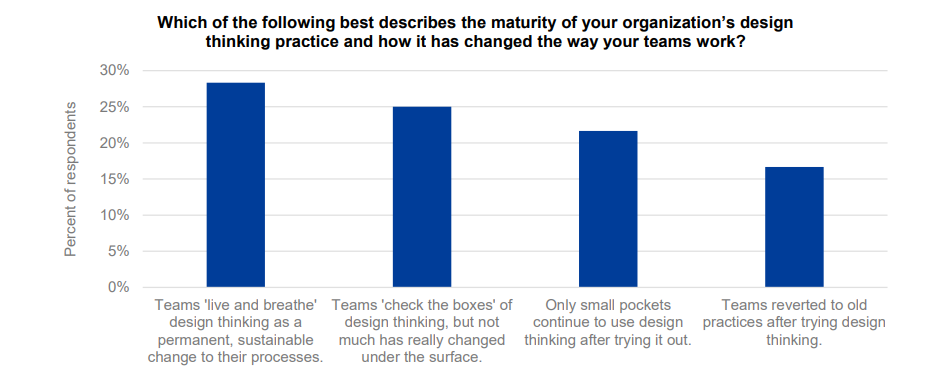Image: wee dezign | Shutterstock
Innovation is often misinterpreted as a sudden flash of inspiration. However, relying on inspiration alone leads to missed opportunities and inconsistent results. Waiting for "lightbulb moments" risks vague goals and untested assumptions, wasting time and resources on ideas that may not solve real user problems.
Based on my experience in product management, innovation doesn't have to be accidental - it can be systematic. Design Thinking turns innovation into a reliable method that emphasizes empathy and testing for every idea. By focusing on empathy, encouraging collaboration, and prioritizing iteration, Design Thinking produces consistent, impactful results.
Here's a breakdown of its principles, benefits, and applications.
Understanding the Gap Between Vision and Execution
Even the best ideas can struggle during execution due to issues like misaligned priorities, vague problems, and insufficient user insights. These challenges lead to products that don't meet user needs, a common issue across many industries. The root cause often lies in a misunderstanding of what users require.
Design Thinking offers a way out of this trap. It shifts the focus from assumptions to real-world insights - getting to the heart of what your users actually need. This method helps teams work together more effectively and keeps everyone aligned on solving meaningful problems.
What Makes Design Thinking Essential in Product Management?
Design Thinking is a systematic approach that helps teams develop user-centered solutions. It promotes adaptability, encourages collaboration, and keeps the focus on solving genuine problems. The five key stages are outlined below.
1. Empathize: Understanding User Needs
This is where you dig deep into understanding your user's world. Conduct interviews. Watch how people interact with products. Listen to their frustrations. Observations, interviews, and empathy maps help product managers identify real issues.
2. Define: Articulating the Problem Clearly
Turn insights into a clear problem statement, setting a focused direction that targets the root cause of user challenges. By defining the problem accurately, product managers guide their teams with focus and purpose, ensuring everyone is working toward solving the right issue.
3. Ideate: Exploring Creative Possibilities
Brainstorm a range of solutions without judgment, sparking creativity and laying the groundwork for innovation. Encouraging different perspectives at this stage generates diverse ideas. For product managers, ideation is where teamwork shines and the seeds of great products are planted.
4. Prototype: Bringing Ideas to Life
Build quick, simple representations to bring ideas to life and allow for early feedback. These prototypes don't need to be perfect - they just need to show the concept well enough to gather insights. For product managers, this stage is about experimenting and turning abstract ideas into something actionable.
5. Test: Refining Through Feedback
Refine solutions based on user feedback to ensure products meet real-world expectations. Testing helps teams make sure their solutions are grounded in real user experiences, reducing the risk of launching something that misses the mark.
Each stage naturally leads to the next, creating a feedback loop that keeps ideas fresh, practical, and rooted in user insight. Design Thinking helps product managers create solutions that truly connect with users and deliver real, user-centered results.
Why It Works
Design Thinking drives measurable success. According to a survey conducted by IBM, investment in Design Thinking led to a 75% reduction in project risk, a 50% faster time to market, and a 20% boost in team efficiency with its adoption.
Yet, its maturity varies. While 28% of organizations embed it sustainably, 22% apply it in limited areas, and 17% revert to old habits. Success requires executive commitment and consistent application.
Source: The Total Economic Impact™ Of IBM's Design Thinking Practice
Revolutionizing Product Development Through Empathy
Empathy fuels innovation. By understanding user emotions, motivations, and frustrations, product managers can design solutions that resonate deeply.
For instance, when developing user-centric tools, it's essential to start with thorough conversations with the end-users. Parents, for example, may seek more visibility over their children's usage, while teens often value their autonomy. Balancing these perspectives can guide product features that bridge communication gaps effectively and respectfully.
How Cross-Functional Collaboration Drives Results
Design Thinking relies on collaboration, bringing together diverse perspectives to drive innovation. In my experience, fostering accessibility and inclusivity through collaboration has been essential.
By involving different perspectives in the ideation phase - from engineers and designers to users with diverse needs - teams can identify pain points and develop features that enhance user experiences across the board. This collaborative approach often strengthens the organization's overall commitment to inclusivity.
Cross-functional collaboration ensures that every voice is heard, fostering alignment and creativity. For product managers, this is an invaluable asset in navigating complex projects.
Bridging the Gap Between Data and Design
Data-driven insights are essential in shaping decisions during the Design Thinking process. Analytics can reveal user behavior patterns, survey results can quantify pain points, and A/B testing can validate assumptions. For instance, data can be used to optimize pricing models and simplify campaign management tools.
Analytics can reveal whether customers struggle with a complex interface. However, it's not until you interview users that you realize why - perhaps they want more control without the extra hassle. Companies can then use these insights to create more efficient campaign tools. The result is a significant increase in add-on revenue and a better experience for everyone.
Image: wee dezign | Shutterstock
Navigating Roadblocks in Design Thinking
Implementing Design Thinking can be challenging due to resistance to change, time constraints, and misaligned stakeholders, especially in traditional organizations that favor rigid processes.
Overcoming Resistance to Change
Teams new to Design Thinking may see it as disruptive. Product managers should introduce it through small, low-risk projects to build trust and show its value by delivering quick wins.
Working Within Time Constraints
Under tight deadlines, thorough user research might seem overwhelming. Instead, use existing data or conduct rapid surveys to gain insights without delaying timelines.
Aligning Stakeholders
Conflicting priorities can hinder progress, particularly in cross-functional teams. Use clear communication, regular check-ins, and shared success metrics to align goals and keep projects moving forward.
Why Iteration is Key to Innovation
Iteration is fundamental to Design Thinking. It encourages teams to refine their ideas continuously, improving products through user feedback. In one of my projects, continuous testing identified friction points in the onboarding process.
Instead of scrapping everything, we went back to the drawing board. By simplifying the steps and testing with real users, we made it easy to get started. This didn't just improve satisfaction; it reinforced the idea that listening to feedback is the smartest way forward.
Expanding the Potential of Design Thinking
The future of Design Thinking is about combining emerging technologies like AI with human empathy. AI tools can improve user targeting and personalize experiences while maintaining privacy standards. Technology enhances efficiency, but human empathy remains irreplaceable. The true power of Design Thinking lies in combining the analytical precision of AI with the emotional intelligence of human-centered design.
Final Thoughts: Lessons for Product Managers
Design Thinking has fundamentally shaped my approach to product management. Its focus on empathy, collaboration, and iteration ensures that every decision is both intentional and user-centric. For product managers, adopting this methodology goes beyond being a best practice - it is a powerful competitive advantage.
Empathy fuels innovation by uncovering user needs, while collaboration enriches solutions through diverse perspectives. Iteration minimizes risk, ensuring products evolve with feedback. Finally, data enhances design, but the human experience must remain central.
If you're a product manager looking to make a real impact, start by getting close to your users. Listen more and test often. Remember: the best products don't just solve problems - they make people's lives a little easier.
About the Author:

Raagini Venkataramani is a seasoned Product Management Professional with a Master's in Computer Science from the University of North Carolina at Charlotte. She has over a decade of experience in leading transformative projects in domains ranging from social media to marketing technology. Raagini specializes in combining user empathy with data-driven strategies to create impactful products that resonate with users worldwide.




